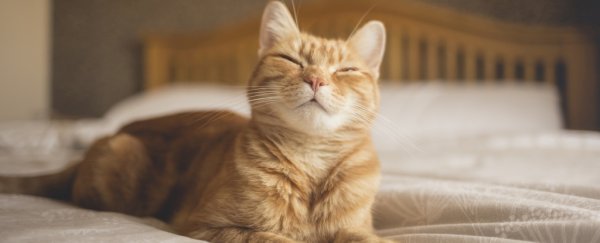Cats have a reputation for aloofness (and flooffiness), but if you and your feline friend aren't bonding, maybe you're just not speaking their language.
Never fear – research from 2020 has shown that it's not so difficult. You just need to smile at them more. Not the human way, by baring your teeth, but the cat way, by narrowing your eyes and blinking slowly.
By observing cat-human interactions, scientists confirmed that this expression makes cats – both familiar and strange – approach and be more receptive to humans.
"As someone who has both studied animal behavior and is a cat owner, it's great to be able to show that cats and humans can communicate in this way," Karen McComb, a University of Sussex psychologist, said in a 2020 statement.
"It's something that many cat owners had already suspected, so it's exciting to have found evidence for it."
If you've spent any time around cats, you've probably seen their 'partially closed eyes' facial expressions, accompanied by slow blinking. It's similar to how human eyes narrow when smiling and usually occurs when the puss is relaxed and content. The expression is interpreted as a kind of cat smile.
Anecdotal evidence from cat owners has hinted that humans can copy this expression to communicate to cats that we are friendly and open to interaction. So, a team of psychologists designed two experiments to determine whether cats behaved differently towards slow–blinking humans.
In the first experiment, owners slow-blinked at 21 cats from 14 different households. Once the cat was settled and comfy in one spot in their home environment, the owners were instructed to sit about 1 meter away and slow-blink when the cat was looking at them. Cameras recorded both the owner's and the cat's faces, and the results were compared to how cats blink with no human interaction.
The results showed that cats are more likely to slow-blink at their humans after their humans have slow–blinked at them, compared to the no–interaction condition.
The second experiment included 24 cats from eight different households. This time, it wasn't the owners doing the blinking but the researchers, who'd had no prior contact with the cat. For a control, the cats were recorded responding to a no–blink condition, in which humans stared at the cats without blinking their eyes.
The researchers performed the same slow–blink process as the first experiment, adding an extended hand toward the cat. And they found that not only were the cats more likely to blink back, but they were also more likely to approach the human's hand after the human blinked.
"This study is the first to experimentally investigate the role of slow blinking in cat-human communication," McComb said.
"And it is something you can try yourself with your own cat at home or with cats you meet in the street. It's a great way of enhancing the bond you have with cats. Try narrowing your eyes at them as you would in a relaxed smile, followed by closing your eyes for a couple of seconds. You'll find they respond in the same way themselves, and you can start a sort of conversation."
Dogs may be much more enthusiastically demonstrative than cats, but this news isn't a surprise for cat lovers. Research in recent years has shown that our feline friends are much more in tune with their human housemates than previously supposed and that comparing them to dogs is a disservice.
Cats, for example, respond in kind to humans who are receptive to them – so if you find cats standoffish, that might be a problem with you, not the kitty. Likewise, cats echo the personality traits of the humans they live with – this may be related to why cats seem to pick up when their humans are sad. They also can recognize their names (although they choose to ignore them a lot of the time). And their bonds with their humans are surprisingly deep.
It's difficult to know why cats slow–blink at humans this way. It's been interpreted as a means of signaling benign intentions since cats are thought to interpret unbroken staring as threatening. But it's also possible that cats developed the expression since humans respond positively to it. With domesticated animals, it's often impossible to tell.
Either way, it does seem to help forge a rapport. And that's a good thing to know. Learning how to improve our relationships with these enigmatic animals could also be a way to improve their emotional health – not just in the home environment but across a range of potentially stressful situations.
"Understanding positive ways in which cats and humans interact can enhance public understanding of cats, improve feline welfare, and tell us more about the socio-cognitive abilities of this under-studied species," said psychologist Tasmin Humphrey of the University of Sussex.
"Our findings could potentially be used to assess the welfare of cats in a variety of settings, including veterinary practices and shelters."
You're going to try it right now, aren't you?
The research has been published in Scientific Reports.
A version of this article was first published in October 2020.
